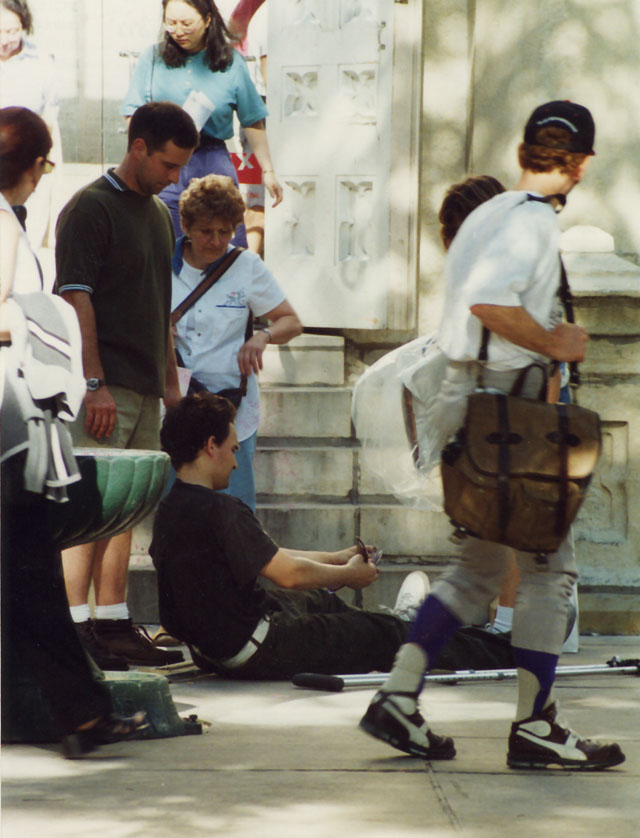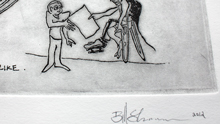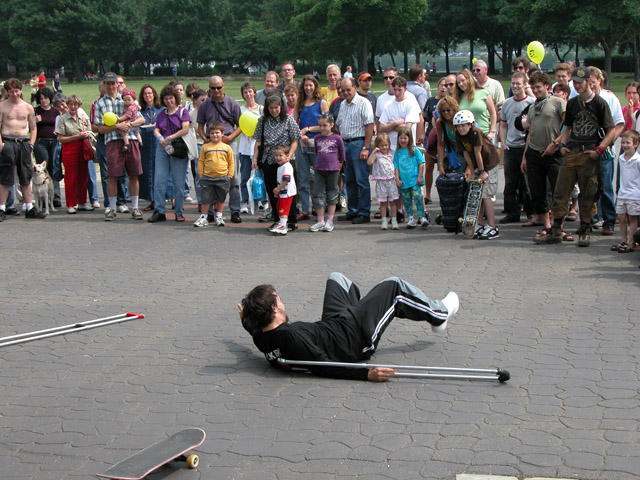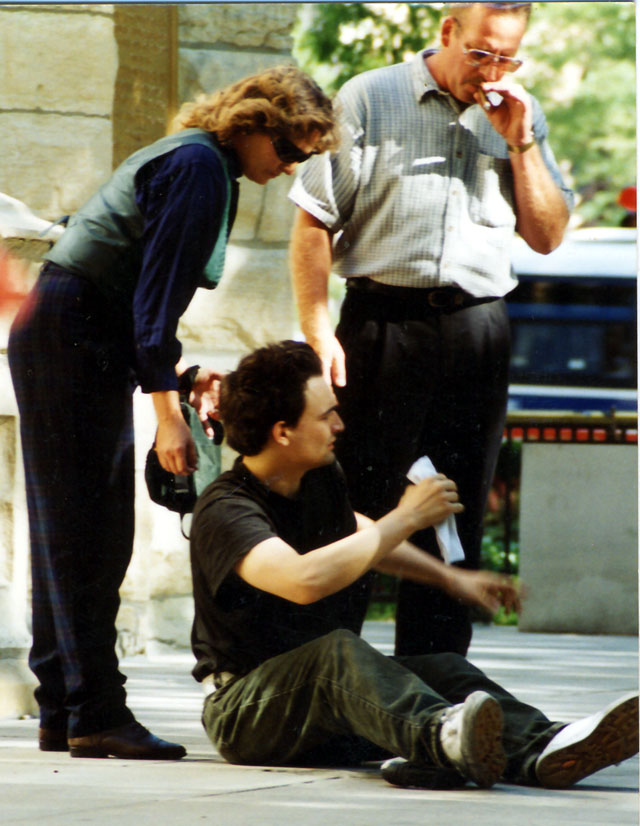TShirts, Stickers, Prints, Art Objects
WhatIsWhat 1.0 2003
WEIGHT OF EMPATHY
ABOVE: Street Performance Pittsburgh 2006 ( i think ) noone from the crowd is helping me off the ground because they just saw the big dance move before the collapse.
Following the "more" is an account of my experience I have written to share publicly a real world example of how the phenomena “Weight of Empathy” plays itself out in my real life. This story will also share how my act of labeling and defining the phenomena “Weight of Empathy” is empowering to me and helps me frame past experiences of it. Finally this story will also provide a context for my practice of sociological anthropology as a performance and language based conceptual art in which the defined and labeled phenomena is explored in realtime and space with the intention of discovering new territories of interaction with the public that subvert or circumvent the standard parameters of a given phenomena.
What is.. Weight Of Empathy? How does it work.?
ONCE UPON A TIME…
I boarded a packed subway car during rush hour with my crutches and skateboard and a heavy bag of books laptop and camera. I wanted to sit down but there were no available seats and no-one offering a seat. I stood for a bit and then to relieve the weight on my arms and hips I put my skateboard down wheels to the floor and then sat down on the board. The commotion of my sitting down on my board alerted people who were seated in the proper train seats that I wanted to sit down to the point that I was willing to sit on the floor. While seeing me standing was bearable or unnoticed, seeing me sit on the floor was for some, insufferable. I would never ask for a seat from the people seated as I had with me a perfect alternative that would not displace anyone whom I knew nothing of their real condition. Furthermore, it is often that the first to stand would be the one who is the weakest and therefore has a more intimate knowledge of what it means to struggle. In real terms the old lady will stand before the young man because she knows more intimately what it means to need a seat. Anyway.. Upon sitting on my board several people immediately offered me their seats which I immediately declined by gesturing with a smile and a wave and a No indication of turning my head. For many this denial of their offer was enough to go back to their reading or staring into nothingness… but for some, they would not be denied so easily. I felt it begin as a man stood up from his seat and left it empty and implored me with repeated gestures to sit in his seat. His wife while he stood and stared at me was also smiling and scooting out of the way further and moving her bags to allow my safe passage. Again I repeated my no indicationa and gestures. Still, they both stared at me along with seemingly the whole car full of people as in disbelief that I was still refusing their kind empathy. The seat remained a gaping empty as time began to crawl and all eyes were on me. I was expected to fall into line, graciously stand and take the seat.. The WEIGHT OF EMPATHY at this moment was crushing me. The reality of my situation was that I was more comfortable remaining sitting on my board. I felt that the effort to stand up, lift my bag up over my shoulder, popup my skateboard and walk to the seat being offered after going through the effort of sitting down in the first place was more difficult and uncomfortable than just remaining seated until arriving at my stop. Yet here they are staring at me as if there is something the matter with me for not reciprocating. I realize that this is a situation where I am now expected to explain myself. I now owe the kind man and his considerate wife an explanation. I am supposed to announce my logic to them. However, I have to point out here also that I am expected to explain myself to perfect strangers in a multitude of contexts on a cumulative basis all day everyday and that even the act of explaining in time becomes a burden. So now I have to decide; do I go through the banality of another explanation of my complex disability based utilitarian logic to some complete stranger who is feeling wronged and may not even comprehend what I am saying or alternately do I ignore them beyond my no thank you indications and tell myself its just another “Weight Of Empathy” and it will be over soon. I have chosen the latter although there is also a third possibility. 
ABOVE: Chicago Street Performance 1995(?) - counting my money while seated on the sidewalk
ADDITONAL NOTES ON WEIGHT OF EMPATHY
Before naming this phenomena I would be subject to it and feel responsible on some level for creating the stressful relationships within it. I did not have a handle for when the phenomena would rear up and thus I could not set it in its rightful place. The sociological anthropology of performative engagements within the realtime space continuum of the phenomena were only possible as the third option after my familiarity with the boundaries of the phenomena and what was expected of me. Within these conceptual works of performance art I can build tools and strategies of behaviors in direct relation to the patterns of the phenomena to subvert it, neutralize it or even at times to inflame it and thereby burn through it. This might happen in a myriad of ways. Going back to the story of when I am offered the seat. What if I then counter their offer by extending them my bag to place in the seat thus meeting both of our needs. I am more comfortable without the bag and the seat they kindly offer to me I put to use. Would they accept this offer as respectful of their empathy? Would I really want them to be responsible for my bag? If I go and recreate this performance as a parallel to my real life and thus take the weight of real implications out of the equation for me could I pass them a bag of paper as a stand in for my real bag contents? Would that be fair to them? What if when they offer the seat to me I in turn offer my pocket change to someone seated nearby? What message would that send to them? Maybe they would see me as insane and sit back down. Maybe they would be offended and interpret my gesture as calling them cheap. The most critical skill in this practice of phenomenological anthropology as a conceptual work of performance art with real world implications is the ability on my part to remain open to the moment and neutral to the momentum of events. I have within this practice developed tools to protect myself from taking advantage of my position. I have a very strong ability to observe from the outside even while in a moment. This is where I share with you that I am a conceptual artist first and a dancer second. “Weight of Empathy” is a name of one phenomena defined and categorized among an invented lexicon of interdependent terminologies that identify phenomena, performance strategies and categories of contexts the phenomena and strategies function within. This is a big part of my work. it has no product, nothing to take home and hang on the wall. it is an art of the idea immaterial. When i diffuse a given phenomena with perfect balance and fairness to all parties it is a masterpiece to the wind.. a quiet understanding . i could tell you stories but even now I feel that words only can take the moments so far. sitting on the floor of the train and looking at the eyes of my fellow passengers as i refused to stand i wondered if it ws maybe just that i sat on the floor. that the floor is a dirty place. nevermind that I am a skater and come out of a hiphop love of the floor.. will dance no matter how dirty. its a cultural thing.. i dont consider the ground dirty, i consider bleach dirty. In the future i will post more descriptions of phenomena as time goes on. finally..it just occured to me that some art is so high its just gone.. maybe this is what i should call this entire body of conceptual art.. gone with the moment
ABOVE: Chicago Street Performance 1995(?) wiping off the dirt
In the performance pictured above I am performing acrobatics on my crutches in the park after which I would collapse in a highly stylized manner to the ground and rest. I would then proceed to clean off with a handkerchief in my pocket before rising to dance again. The image above shows two individuals waiting on me to wipe off my body which was a long extravagant and even at times borderline paranoid event. The people sitting around who were able to observe the entire continuum of my dance into the collapse were laughing outloud while the people who had just arrived to see me on the ground were trying to immediately stand me up. I would push at the parameters of what the pedestrians would accept as sane behaviour before moving on and leaving me seated. In the image here the cigar smoker walks away tkaing his partner with him. To ground this public work exploring the range of representation from heroics to failure I think the following story really will help. I once did a workshop with highschool students in Chicago where one brave black kid took my crutches and danced around in the park (not so convincingly as he had no practice) and then artfully collapsed to the street. (again not so convincing) Once he was seated however the difference in the pedestrian reaction was considerably less alarmed and overwhelmingly less likely to stop and help. The fact that it took so long for him to have someone try and help him compared to my relative inability to touch the ground without a disruption of pedestrian traffic underlines the fact that disability as an identity is only one of many in play. In this public series of works involving difficult acrobatics on crutches offset by actions which could be construed as failure the role of race, class and gender were as important to my experiences with the public as disability. i never take this for granted. Here I would point to the work of another public performance artist who pushes such questions of identity into the public sphere in a siimilar though very different way than my own work. This artist is William Pope L. I have a tremendous amount of respect for his work and see his questions and how he asks them as in a similar vein to where I am at. His crawl series would be of particular relevance to this post.
THE ORIGINAL WHATISWHAT.COM
For more writings about phenomena and th einvented lexicon I have evolved to handle the conceptual nature of the performance I suggest you take a look at the original version of whatiswhat.com which I have added to the left sidebar. The graphic on the sidebar image is the same as a standard sized business card I created that says "The Answer" on one side with "flip" in the bottom right corner. When you flipped to the back of the card it reads "whatiswhat.com" with the same "flip" in the bottom right corner. I would hand this card to strangers in the street after they had asked me questions like "What happened to you?" or "What do you call that?". It was a fun little card that helped quickly deflect the many questions I get on a daily basis in public. Of course some people were offended by this repsonse instead of a genuine answer while others would flip the card one or even two times before getting it. For the most part the card was a practical tool that made people laugh and let me off the hook.
BELOW : A definition of conceptual art and a definiton of Lexicon
(l k
k s
s -k
-k n
n )
)
 )
)



